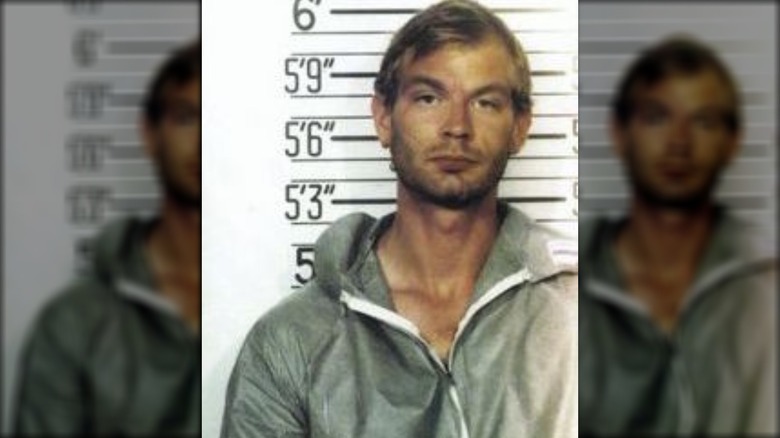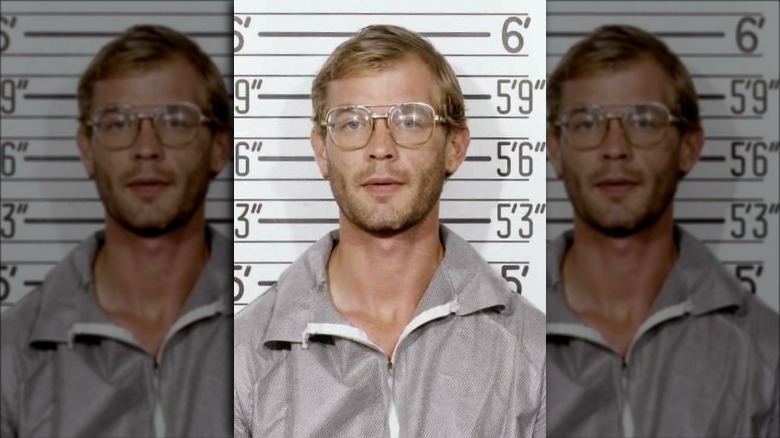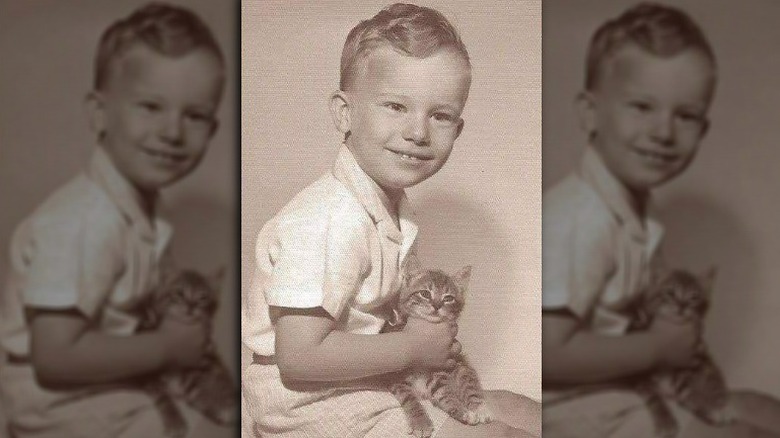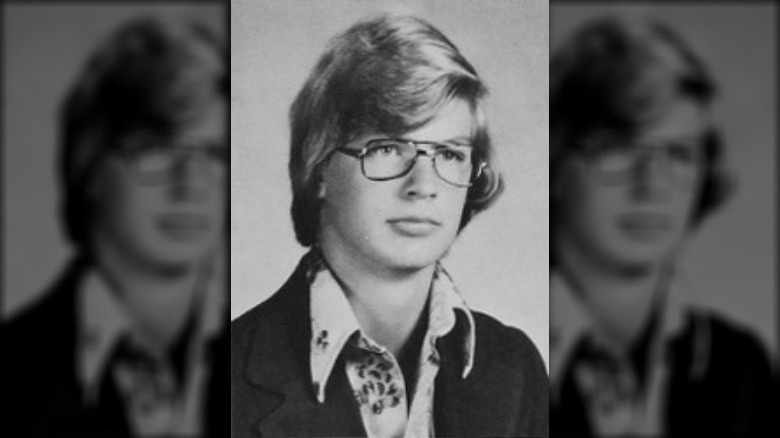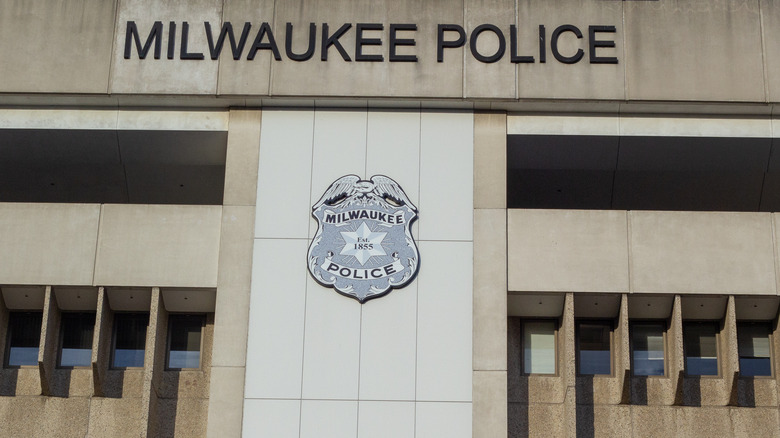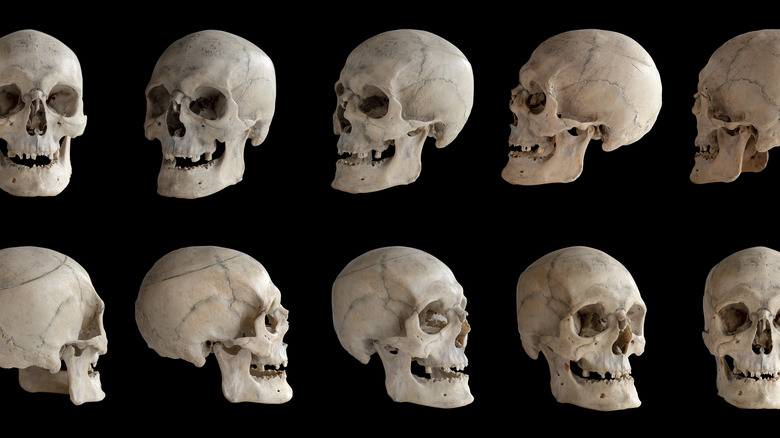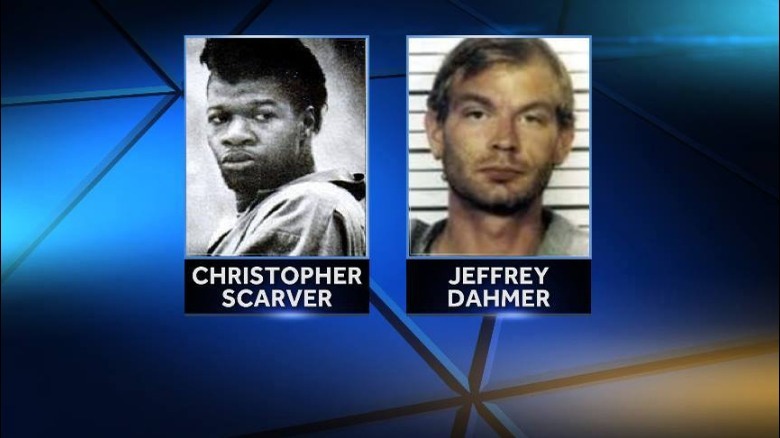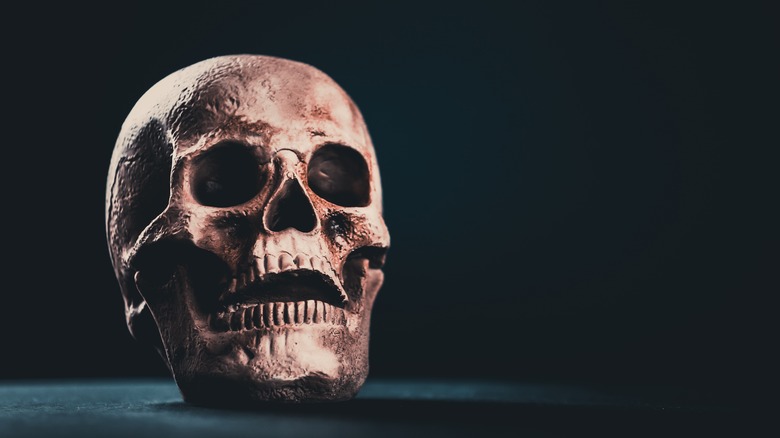The Untold Truth Of Jeffrey Dahmer
Jeffrey Dahmer was arrested at his Milwaukee apartment in 1991, and when the full extent of his crimes came to light, everyone was shocked — even the FBI, who described his apartment as "what could have been the set of a horror movie — numerous body parts belonging to multiple victims." It wasn't until 1992 that prosecutors charged him with 15 murders. Remains of 11 of those victims were still in his apartment at the time of his arrest. Dahmer would ultimately be sentenced to life in prison before being shipped off to Ohio, where he was convicted of one additional murder.
After his conviction, Dahmer spoke about what drove him to kill. He once told Inside Edition (via Oxygen), "It's a process, it doesn't happen overnight, when you depersonalize another person and view them as just an object. An object for pleasure and not a living, breathing human being. It seems to make it easier to do things you shouldn't do." Dahmer explained at his trial he had always known what he was doing "was sick or evil," and continued — "Now I believe I was sick. The doctors have told me about my sickness and now I have some peace."
Jeffrey Dahmer remains one of the most notorious serial killers in U.S. history. So what was never revealed until much later ... and how much has the world forgotten?
The unspeakable crimes of Jeffery Dahmer
At the heart of the horrors is, of course, Jeffrey Dahmer himself. When it came time for experts to determine if he was fit to stand trial, forensic psychiatrist Dr. George Palermo spent more than 12 hours interviewing him, and concluded (via the Chicago Tribune) he was "highly intelligent, emotionally tranquil, and his thinking processes were logical and rational." And somehow, that makes what they found in his apartment more terrifying.
When The Associated Press picked up the story of Dahmer's arrest from The Milwaukee Sentinel in July 1991, they reported law enforcement "found 11 skulls scattered in a file cabinet, a closet, a refrigerator, and a freezer, and three headless torsos in a vat in the man's bedroom." That vat, says History, was a 57-gallon drum filled with chemicals that were contributing to the slow decomposition of the bodies inside. There were three heads in the refrigerator, and "evidence" some of the victims had been cannibalized. When police started emptying the apartment, they took out "boxes filled with body parts," and as neighbors started to realize what was happening, the "sounds of sawing [that came] from the apartment at all hours" and the smells became clear. Dahmer's neighbor, Ella Vickers, said, "We've been smelling odors for weeks, but we thought it was a dead animal ... We had no idea it was humans."
Just how many humans it was ... that was documented in a dresser drawer full of Polaroids.
The harrowing life-and-death struggle that led to Jeffrey Dahmer's arrest
Jeffrey Dahmer's arrest wouldn't have happened ... if it weren't for a few Polaroid pictures carelessly left in plain sight. It wasn't until officers got a glimpse of those that they realized something was deeply wrong, as they doubted the man who fled to them for help.
Dahmer was originally arrested in 1988, on charges of (via Time) "fondling a 13-year-old Laotian boy." After 10 months in jail, he regularly met with his probation officer who, in turn, never checked his home. That freedom, History says, coincided with Dahmer the first of the victims later found in his apartment, who had vanished in March 1989. Just two months after that disappearance, Dahmer was before a judge — and promised his child-molesting ways were behind him.
Fast forward to July 22, 1992. That's when Tracy Edwards escaped from Dahmer's apartment, and he later testified (via the Los Angeles Times), "He put his head on my chest, was listening to my heart, and said he was going to eat my heart." After watching "Exorcist III," Edwards was able to hit — and flee from — a distracted Dahmer. Heading out into the city, Edwards found a police car and told officers what had happened — and showed them the handcuffs still around his wrist. When he took the doubting officers back to the apartment, Dahmer originally tried to explain the incident away as a "domestic dispute," but that's when officers spotted the pictures. Dahmer was arrested without incident.
Jeffrey Dahmer's childhood was destroyed by a single incident
A 2005 study published in the Journal of Police and Criminal Psychology found childhood abuse — including physical, sexual, and psychological abuse — was present in the history of a high percentage of those people who grew up to become serial killers. When it comes to Jeffrey Dahmer, his case is a little unique in that his father wrote a book about raising his son — and the problems he saw from a young age (via Regis University).
In interviews his parents gave after his arrest, they described Dahmer as a toddler: "[He was] a happy young boy who loved animals and nature." But things started changing when Dahmer was just 4 years old and had surgery to repair a double hernia. Afterwards, he became convinced his genitals had been removed. His father has suggested that was connected to his later habit of castrating his victims, and he's also pointed the finger at other elements of his son's childhood that may have had some severely negative impacts on him.
That includes being witness to the side effects his mother suffered from after starting anti-anxiety medication, along with abandonment issues stemming from parents that largely left him — and later, his little brother — to fend for themselves. Father Lionel Dahmer would later write, "It is a portrayal of parental dread ... the terrible sense that your child has slipped beyond your grasp, that your little boy is spinning in the void, swirling in the maelstrom, lost, lost, lost."
The fetal pig
Research done by Regis University suggests Jeffrey Dahmer's fascination with death started at about the same time as his hernia surgery — and an incident recounted by his father. Lionel Dahmer says 4-year-old Jeffrey was fascinated with a pile of bones under their home, and while Lionel noticed it, he didn't do anything about it — and Jeffrey's interest in the dead and dying only increased.
When Jeffrey Dahmer was in the ninth grade, he was given a biology assignment that might sound familiar to those of a certain age: the dissection of a fetal pig. He not only happily completed the assignment but kept the skeleton — and that kicked off an obsession with collecting others. At first, those came from along the roadside; Dahmer spent much of his formative years collecting dead animals and mutilating them further.
The Miami Herald says Dahmer also killed the pets of his neighbors, mounting their heads on sticks. Today, animal cruelty is considered one of the warning signs a child might escalate in adulthood. The FBI started maintaining a database to track instances of animal cruelty in 2016, and stress that instances of abuse need to be reported.
'Somebody else's problem'
John Backderf says he occasionally wondered what happened to his old school chum Jeffrey Dahmer, but it wasn't until 1991 headlines that he learned what his buddy had been up to. Backderf told The Independent, "There was always a darkness about him that was really kind of repellent ... I was OK with hanging out with him, if there was other people around. I was never going to be alone with him. And I'm pretty happy I had that instinct, because that could have well been me chopped up in the trunk of his car."
Backderf was already an established artist when he decided to tell his story in the form of the graphic novel "My Friend Dahmer." The 2012 work — which was turned into a movie — tried to shine some light on what it was like going to school with him. Dahmer, he says, started acting out in high school: He would fake seizures, and mock locals with disabilities. Backderf and his friends jokingly formed the Dahmer Fan Club. Backderf wrote: "All those things he perfected when he was very young through our goofball antics, he used them when he was a monster. That's a little hard to live with."
And it's also led him to wonder where the adults were. "They didn't care," Backderf says. "They just ... figured, 'Well, next year he'll be somebody else's problem.' And of course he was somebody else's problem."
The first victim
Jeffrey Dahmer's parents finalized their divorce on July 24, 1978 (via the Los Angeles Times). About a month prior to that, he killed his first victim. Steven Hicks had been hitchhiking to a concert, says The New York Times, and when he didn't come home, his parents didn't think anything of it. They reported him missing six days later, but he was already dead.
Months passed ... then years. It wasn't until 1991 that law enforcement connected Hicks' disappearance with Dahmer, and it was also then they started taking a close look at Dahmer's 1978 home in Ohio. Hours into the search, they "found more than 50 bone fragments," along with a "'substantial quantity of blood' and a bloody handprint in the crawl space" of the home.
That would quickly escalate to 500 bone fragments, and Dahmer would eventually confess to picking up Hicks, inviting him home for a drink, and smashing him first with a barbell, then destroying his remains with a sledgehammer. And he was nearly caught. Dahmer was pulled over by police when he was disposing of Hicks' body, and officers asked him why he had plastic bags in his car. He convinced them he was just getting some air — and, distraught over his parents' impending divorce — he was taking the garbage to the dump while he was out. Officers let him go.
Jeffrey Dahmer's time in the military
In 2013, The Independent did a profile on those who had been victims of sexual assault while in the military, and among those were two men who had been victimized by Jeffrey Dahmer. Dahmer enlisted and was sent to Germany in 1979, where he was attached to a medic unit. One of the other men in the unit, Preston Davis, says he was drugged then sexually assaulted by Dahmer: "I was raped by Jeffrey. I am just thankful to be alive to tell the story."
After Davis left the Baumholder garrison, he was replaced by a soldier named Billy Joe Capshaw. After being sexually assaulted multiple times, Capshaw jumped from a third-story window, survived, and reported the assaults. Superior officers returned him to the barracks where the abuse continued, and after he left the military, he spent five years locked in his own room. After years of therapy — and a friendship with Dahmer's other victim — he was finally able to talk about what happened.
Davis says (via The Wrap) Dahmer liked to boast about how he'd killed a man — Hicks — when he was drunk, and he was ultimately discharged because of his alcohol abuse. Davis continued: "I don't consider myself a victim. I'm a survivor."
The boy that raised the alarm
St. Mary's University says Konerak Sinthasomphone was among the 11 victims whose remains were discovered at Jeffrey Dahmer's apartment, and his story starts years prior. The 13-year-old boy Dahmer had been convicted of molesting in 1988 was Konerak's older brother, Keison. The family was told Dahmer was "put away for good," but in 1991, he lured Konerak Sinthasomphone to his apartment with promises he'd pay him for posing for a few photos. Dahmer drugged him, drilled a hole in his skull, and injected him with hydrochloric acid.
He was still unconscious when Dahmer left for the store, and Dahmer was still gone when he woke. Sinthasomphone was running down the street when he came across Nicole Childress and Sandra Smith. They called police, but by that time, Dahmer was on the street again to reclaim his victim. Dahmer claimed the boy was his "houseguest," and was ultimately released by police — who escorted them both back to Dahmer's apartment, then threatened to arrest Smith for her continued insistence that something was deeply wrong. Sinthasomphone was dead half-an-hour later.
In spite of the fact that Dahmer already had another body in his apartment, the officers testified (via The New York Times) they believed the two had "a caring relationship." Officer Joseph Gabrish said, "We're trained to be observant ... I've been doing this for a while, and usually if something stands out, you'll spot it. There just wasn't anything there."
Jeffrey Dahmer's desire for 'zombie sex-slaves'
Jeffrey Dahmer's crimes weren't actually driven by anything as straightforward as a need to kill and cannibalize; there was something much more complicated at work.
When he confessed, it was in a 145-page missive (via Psychology Today) where he shared the fact that unresponsive bodies and dismembering the dead "aroused him." That was just the beginning. Autopsies (via Acad Forensic Pathol) performed on the remains recovered from his apartment revealed he'd drilled holes in the skulls of his victims — while they were alive, based on signs of healing. When detectives confronted Dahmer, he admitted he had been experimenting — by varying the number and size of drill holes, and the liquids he then injected into his victims' brains, he'd hoped to turn them into "zombie sex-slaves."
At his trial, jurors were presented with the idea that Dahmer did what he did because he didn't want to be alone (via the Nelson Mandela Metropolitan University): The creation of his zombie slaves would mean he had "people who would be there for him," and he claimed it was a similar need that drove him to keep the skulls and eat parts of his victims. That way, they "would become alive again in him."
Here's what his parents thought
Jeffrey Dahmer's parents have spoken out about their son, and his father — Lionel — even wrote a book in an attempt to make sense out of what had happened. In it (via Oxygen), he said he "blamed himself for Jeffrey's (severe) flaws," particularly his own "negligent" nature.
Jeffrey's mother, Joyce Flint, said in 1993: "I wake up every morning and for a split second, I don't know I'm Jeffrey Dahmer's mother, and then it all floods in." She later told Hard Copy, "I still love my son. I've never stopped loving my son." Flint died of breast cancer in 2000, and in reporting her death, Deseret says she spent much of her life working as a case manager for the Central Valley AIDS team. She also founded an HIV community center called The Living Room, and associates described her as "just this wonderful person."
Jeffrey Dahmer's stepmother, Shari, has also spoken about her infamous stepson. She says (via In Touch Weekly), "He was very vulnerable. He needed love and he needed attention." She adds that they did try to get him psychiatric help after he left the military, and when asked why they hadn't changed their names, she adds: "I didn't feel ashamed. We were not guilty ... Because we were not involved, we didn't feel ashamed in that respect."
Here's how much Jeffrey Dahmer made while in prison
After Jeffrey Dahmer's confession and conviction, came jail — and while he was there, he started receiving a ton of fan mail. His father wrote (via Oxygen) that he was baffled by it: "Clearly, some of these people believe that in some bizarre way, my son could rescue them from lives in which they felt trapped. It demonstrated a level of sympathy and pity that I simply could not reach."
In 1994, The Associated Press reported that Dahmer had already received a shocking $12,000 in letters that were sent to him from across the globe. Some sent him money to spend on creature comforts, while others sent donations as gifts — with at least one woman hoping that the $350 she sent him would encourage him to learn about Christ.
The New Statesman took a look at some of the so-called serial killer fandoms and found a secret Facebook group filled with Dahmer fans. As a play on his cannibalism, they called themselves "McDahmer's," and when the paper spoke with one member (49-year-old "Geri"), she revealed that she felt connected to Dahmer because they shared "a great hobb[y]" of dissecting animals. She explained, "It's not that I agreed with what he did, but I understood the triggers. Society has a lot to answer for in terms of how people turn out."
Why Christopher Scarver killed Jeffrey Dahmer
Jeffrey Dahmer was ultimately sentenced to 16 consecutive life terms, says Biography, and at first, he spent some time in protective custody. After a year in jail, he asked to be returned to a more communal area, and he started to spend time — sometimes, unsupervised — with other prisoners. That's where things went sideways.
There was an attempt on his life in 1994, at a chapel service the newly-baptized Dahmer was attending. Then, on November 28, 1994, Dahmer was bludgeoned to death by another inmate named Christopher Scarver. Scarver later talked to the NY Post and explained why he'd done it, saying: "He crossed the line with some people — prisoners, prison staff. Some people who are in prison are repentant — but he was not one of them." Scarver wasn't the only one unnerved by Dahmer, he said. Dahmer was well-known for hanging up signs for "Cannibals Anonymous," and reminding guards and fellow inmates alike that, "I bite." He made severed limbs out of his food while in the mess, added ketchup for blood, and taunted those around him.
Scarver said that he had gone out of his way to avoid Dahmer, but then he found himself on bathroom-cleaning duty with him. He was poked in the back, and when he confronted Dahmer with his crimes — and Dahmer confirmed that he was guilty — Scarver said, "He ended up dead. I put his head down."
He committed crimes in his grandmother's basement
Though much of the focus of Jeffrey Dahmer's crimes center around his Milwaukee apartment, this residence was not the only place where he committed them. His second victim, Steven Tuomi, was killed by Dahmer at the Ambassador Hotel, his remains disposed of in trash bags (via USA Today). Living with his grandmother at the time, Dahmer began taking his prey back to her home. The murders of James Edward Doxtator, Richard Guerrero, and Anthony Sears all took place here (via Biography) with Dahmer dismembering and disposing of the bodies. "Jeffrey Dahmer — Serial Killer and Cannibal — More Murders, More Arrests" revealed that though the murders took place in her basement without her having any knowledge of them, his grandmother was growing weary of Dahmer's rampant alcoholism and male company. In one instance, a would-be victim of Dahmer's narrowly escaped death as Dahmer's grandmother surprised him by coming home earlier than expected. Already drugged, the Associated Press reports that Ronald Flowers, Jr., woke up in a hospital the day after an encounter with Dahmer. Dahmer later admitted to investigators after his eventual arrest for murder that he only let Flowers live because he thought that his grandmother had seen him.
In 1994, NBC's "Dahmer and Dahmer" (via Yahoo News) reported that Dahmer was admittedly gay, something that he struggled to reveal to his family. His grandmother was especially conservative and became motivated to expel him from her home when she discovered him with a "partially naked man."
Was he planning to create an altar made of bones?
Jeffrey Dahmer's apartment was full of ghastly discoveries when police were called there in July 1991. Along with the murder weapons and various instruments used to dissect his victims, investigators discovered multiple body parts stashed in locations throughout apartment 213.
Among the relics Dahmer had collected from his victims was a crude set of hand-drawn plans for a shrine made with human skulls. Fox News reports that Dahmer's plans revealed a black table, illuminated with overhead blue lighting that would shine on the painted skulls that he collected from his victims. The shrine would be guarded on either side by two human skeletons, also painted.
For Dahmer's plan to come to full fruition, many more victims would have been required. And Dahmer had no plans on discontinuing his cruel and morbid hobby. In a 1993 prison interview with Inside Edition, Dahmer was asked if he would still be committing murder. His chilling response was "There's no doubt I probably would be. I can't think of anything that would have stopped me."
What did Dahmer do for work?
When Jeffrey Dahmer was arrested in July 1991, he had last been working at the Ambrosia Chocolate Factory in Milwaukee (via The Milwaukee Journal Sentinel). He had been fired from his position four days after he murdered his 16th victim, 24-year-old Oliver Joseph Lacy. Biography details how his poor attendance led to his termination, but this news didn't do anything to slow his killing spree. The very day he was let go, Dahmer killed his final victim, 25-year-old Joseph Bradehoft.
Before his days at Ambrosia, Dahmer held a variety of jobs, though he didn't keep them for very long. After dropping out of college in 1979, Dahmer joined the military where, according to The Akron Beacon-Journal, he wanted to become a military police officer. Assigned instead to the role of a combat medic, Dahmer was assigned a station in Germany. His severe abuse of alcohol led to his discharge a mere two years into his enlistment.
Deemed unfit for military duty, Dahmer moved to the Miami, Florida, area so that he could be in a warm climate. He moved into a motel and took a job in a sandwich shop. The Galveston Daily News tells us that he soon moved to the Milwaukee area to live with his grandmother. Dahmer worked at the Milwaukee Blood Plasma Center as a phlebotomist, admitting to police that he drank blood from a vial while employed there (per USA Today). Ambrosia hired Dahmer as a night laborer in 1985.
He once brought a human head to his job at a chocolate factory
You can probably imagine the running jokes about a cannibal being employed in a chocolate factory that were tastelessly made (no pun intended here) when Jeffrey Dahmer's most recent vocation was revealed after his 1991 arrest. No doubt, these attempts at humor were woven into a fabric of real horror that was being exposed after Dahmer was brought to justice and throughout his 1992 sanity trial.
Biography reveals that Dahmer began to collect trophies from his victims, in the form of body parts that he harvested from them after they were viciously murdered. The first time Dahmer admitted to doing this was with the body of his fifth victim, Anthony Sears. The 24-year-old man was lured to Dahmer's grandmother's house where he was strangled to death and dismembered. Dahmer carefully removed Sears' head and genitals, storing them inside a wooden box.
This box was brought to work at Ambrosia by Dahmer, who kept the box and its contents in his work locker.
What happened to Dahmer's body after his death?
In some instances, the remains of a convicted killer go unclaimed and are buried without much fanfare in a prison cemetery. In the case of Jeffrey Dahmer, he had several family members who stayed in close contact with him throughout his incarceration and wanted to take possession of his body after he was murdered in a prison shower in November 1994 (per History). But the trial against Dahmer's killer, Christopher Scarver, delayed any final action being taken on his body.
According to the Associated Press, Dahmer's body was finally allowed to be cremated in September 1995, an option that his father and mother opted for so that they could save on storage costs while the court ruled on the fate of Dahmer's preserved brain. Though his parents agreed to split his ashes, they were on opposing sides as to the fate of the organ. Dahmer's father wanted the brain to be cremated along with the rest of his body, while his mother wanted it to be studied by scientists. The Associated Press (via NBC 5 News Chicago) reported that eventually Dahmer's father got his way and the brain was cremated.
His apartment building was demolished
Those wanting to drive by and sneak a peek at the apartment building that Jeffrey Dahmer lived in while he committed the majority of his murders will be disappointed to discover that it hasn't been standing in 30 years. The Milwaukee Journal Sentinel reports that the structure at 924 N. 25th Street was demolished in 1992, a little over a year after the remains of multiple victims were recovered from Dahmer's home.
The building was purchased by The Campus Circle Project, in conjunction with Marquette University. Though some discussions were had about what to do with the property over the years, nothing has come to fruition. Newsweek reports that after the buyers helped the existing residents of the building acquire new housing, they deliberated on using the now-vacant lot for a memorial garden for victims, a neighborhood park, and other projects. Three decades later, the grassy lot still sits undeveloped behind a fence.
The decision to purchase and raze the dwellings where brutal murders have occurred is not uncommon. The high levels of publicity might be a dominant motivating factor in this move, as it keeps curiosity seekers from bothering neighboring property owners. Over time, true crime aficionados have seen the homes of the Kansas City Butcher, John Wayne Gacy, and others destroyed so that adjacent residents can move on with their lives (per The Pitch KC and Chicago Business Journal, respectively).
What happened to Dahmer's estate?
After Jeffrey Dahmer's 1991 arrest, his Milwaukee apartment was thoroughly searched by investigators who made countless grisly discoveries. After Dahmer was sentenced, a civil trial was underway, brought into the court by surviving members of Dahmer's many victims. The Orlando Sentinel reports that they were awarded $80 million, an amount that Dahmer was unable to pay. These parties decided to auction off the various items belonging to Dahmer, hoping to raise as much as $1 million, the proceeds of which would be split among them (via CNN).
The items that were to be auctioned were the only remnants of Dhamer's estate and included an estimated 300 objects. Included in the proposed sale were ghastly items, like the vat that he used to boil away his victim's flesh, the refrigerator that held the remains of some of his victims, the hypodermic needles he used to inject his prey, and the tools he used to carve away their flesh. Also included were seemingly mundane articles, like the convicted cannibal's toothbrush (via Newsweek).
A group of Milwaukee businessmen organized in opposition to the auction and petitioned the court to turn over the contents of Dahmer's estate over to their Milwaukee Civic Pride Fund. The Associated Press tells us that the fund's organizer, Joseph Zilber, was granted the right to purchase the contents from victims' family members. Zilber managed to raise more than $400,000, which was split between the families. After gaining possession of the articles owned by Dahmer, they were destroyed.
He had a reason for taking his glasses off in court
Amid Jeffrey Dahmer's trial in 1992, his father and stepmother sat down with TV's "Inside Edition" in an exclusive interview (per Deseret News). During the session, Shari Dhamer pointed out that her stepson was not wearing his prescription glasses in the courtroom. Not wanting to be able to see the jury or onlookers in the chamber, he sat through the legal proceedings without them. She stated, "He's not wearing glasses so that he can't see people. He panics." Whether this feeling was from guilt or regret, she did not speculate.
On February 17, 1992, Dahmer stood before the court once more after the jury found him legally sane two days prior. Facing multiple life terms for having been found guilty of 15 counts of first-degree murder, Dahmer found himself listening to multiple statements from the family members of many of his victims (via CBS News). After sitting silently throughout some very passionate and emotional testimony to the court, Dahmer was given the opportunity to address the judge and those in attendance.
Deseret News reports that the only time that Dahmer wore his glasses was during this sentencing hearing.
